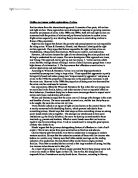Assess the usefulness of realist explanations of crime and deviance
Within sociology, there have been many different theories designed to help explain why crime and deviance takes place. This essay will be focusing on the realist perspective. The realist perspective can be broken down in to two categories, right realism and left realism. Right realism comes from a political functionalist point of view; where as left realism comes from a neo-Marxist point of view. The main aim of this essay is to asses the usefulness of realist explanations of crime and deviance. To do this it will be looking at the good and bad point of both ends of the spectrum, followed by a final conclusion. The realist approach can be seen as a reaction to both the labelling theory and radical criminology.
Right realism was the first type of realism to come about and takes a more realistic look at crime and deviance. Right realists believe that there are many causes of crime and deviance. They believe that in order to cut down crime and deviance they need to enforce a zero tolerance policy, which they believe will make everything safer for people on the streets and in their homes They also question the view that poverty and unemployment are responsible for the rising rate of crime and deviance and turn more to a cultural explanation. Wilson furthers this statement and claims that affluence and poverty may go hand in hand with the increasing amount of crime being committed. A lot of emphasis is put on the fact that there are a lot of fatherless families and the fact that it has an effect on young men who do not have an older male role model to look up to. Wilson and Hernstine argued that the way young men are socialised within the family, education and the wider community has an important effect on their behaviour. Right realists also see the lack of family values, mainly discipline, from inside and outside of the home as a reason for the high rate of crime. Murray believes that the socialisation and role models that are needed for young men growing up are often lacking in female headed low-income families. Wilson believes that the way to stop crime from increasing is by increasing the chances of a criminal getting caught buy doing things such as more policing. He mainly focuses on social control as a reason for crime and deviance. Where Wilson believes that that high crime rates are due to socialisation, Murray believes that it is all down to the welfare state. It is argued that the welfare stated has created a dependency culture where by people have become married to the welfare state. This falls under the social control theory which mainly focuses on the factors that prevent people from committing crimes. He also believes that the only solution I to cut down on welfare benefits or to completely stop them in an attempt to make people stop depending on the state and start depending on themselves by taking responsibility of themselves. He also recommends that people should be penalised for having births outside of marriage and that the idea of marriage and the nuclear family should be reinforced. He believes that without these changes taking place, the underclass will continue to reproduce its self from generation to generation. In terms of the social order and crime prevention view, crime reduction means raising the benefits of conformity and increasing the costs of crime. This argument goes hand in hand with Wilson and Hernstines argument that crime rates will change if there are changes in the costs and benefits of committing crime. They also argue that there is an important element of choice where deciding whether or not to commit a crime. In terms of this view, crime reduction means increasing the costs of crime and raising the benefits of conformity. The two measures that will increase the costs of crime are target hardening, which reduces the physical opportunities of offending and surveillance such as CCTV which is already being used within society. Wilson and Kelling argue that crime and social disorder go hand in hand.







